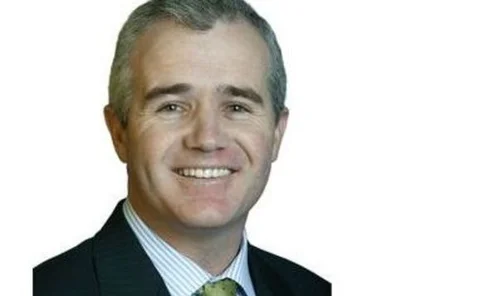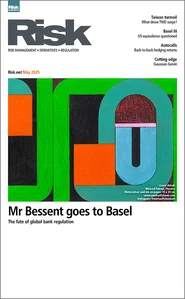Risk magazine - Volume 23/Number 5
Articles in this issue
LCH.Clearnet considers revaluing $212 trillion swap portfolio
LCH.Clearnet could start using overnight indexed swap (OIS) rate curves rather than Libor to value its roughly $212 trillion swap portfolio, in response to changing market practice.
LCH.Clearnet CEO calls rival 'reckless' as Fannie, Freddie clearing battle heats up
Politicians love the idea of central clearing, but with competition for this new business increasing, so are concerns some venues might not be robust enough.
Goldman charged over CDO role
The US Securities and Exchange Commission filed a lawsuit against Goldman Sachs in April, alleging the firm misled clients. Some observers suggest the action may not be successful, but criticise Goldman’s behaviour. By Mark Pengelly and Duncan Wood
Banks run eurozone crisis scenarios as Greece founders
With markets anticipating a Greek debt restructuring, bank traders and risk managers are preparing for a wider crisis that could drag in northern European countries, tip the euro into a tailspin or even threaten the eurozone’s integrity.
State benefits for RBS
Jezri Mohideen, head of rates trading for Europe, the Middle East and Africa at RBS, talks to Alexander Campbell
A dynamic model for leveraged funds
Guido Giese derives a model for the performance and Sharpe ratio of leveraged and inverse index funds that follow a dynamic leveraged trading strategy, that is, they are rebalanced on a daily basis to ensure a constant degree of leverage with respect to…
Expanded smiles
Implementing models with stochastic as well as deterministic local volatility can be challenging. Here, Jesper Andreasen and Brian Huge describe an expansion approach for such models that avoids the high-dimensional partial differential equations usually…
A new VAR terminology
In the first of a four-part series, David Rowe considers the development of financial risk management over the past 25 years and offers some thoughts about its future direction
Capturing fat tails
Financial institutions are more aware of the risks posed by high-impact events since the crisis, but the question is how to encapsulate these in models. Zari Rachev, Boryana Racheva-Iotova and Stoyan Stoyanov discuss three approaches for capturing fat…
Towards a global valuation model
Banks use a variety of pricing models across business lines, creating discrepancies in the way various financial instruments are priced. But developments in high-throughput computing could lead to the possibility of a global valuation model, argue…
The inflation pricing conundrum
Fear of a spike in consumer prices has created greater demand for inflation protection from a variety of participants. This has increased the need for inflation pricing and analytics tools – but it is not as simple as tweaking existing models used for…
Inflation issuers face Greek fallout
Issuance of sovereign inflation-linked bonds is expected to reach record highs this year as governments struggle with vast fiscal deficits. With investors shaken by the crisis in Greece, however, some issuers may have to draw on the lessons of the crisis…
A return to domestic inflation
Activity in Europe’s domestic inflation derivatives markets dropped away after the collapse of Lehman Brothers. Now, dealers report buyers and sellers are starting to return. But there is likely to be less warehousing of risk by banks and a greater focus…
Losing the asset swap lifeline?
A price difference between inflation-linked and nominal bonds last year created a huge opportunity for real-money investors to benefit through asset swaps. Now the opportunity has diminished, how important are asset swap investors in providing inflation…
Optimism for property derivatives
Despite massive global real estate losses, the property derivatives market has been largely ignored, with trading activity focused almost exclusively in the UK. What are the prospects for growth in the asset class? By Peter Madigan
Cat bonds return
The market for catastrophe bonds dried up in 2008 and early 2009 as the financial crisis took its toll. Confidence is returning, helped by wide spreads and a re-think about the assets used to collateralise catastrophe bonds, but issuance has yet to…
Waiting for CCP standards
Proposed standards for central counterparties clearing over-the-counter derivatives will be published in May, tackling contentious issues such as governance, margin practices and default management. Dealers are anxious to ensure the standards are…
Prime brokers move to SAS 70 audits
Learning from the default of Lehman Brothers, a growing number of prime brokers are adapting their business model to ensure margin is segregated and secure, with some looking to win third-party validation for the controls they have in place. Which firms…
Buy side steers clear of CCPs
Regulators have pushed hard to ensure buy-side firms are able to access central counterparties since the crisis began. But despite the launch of several new services, very few buy-side participants are actually using them. By Mark Pengelly
Dampening pro-cyclicality in margin
The Committee on the Global Financial System has released a proposal recommending changes to dampen pro-cyclicality in margin practices and haircuts for securities financing and over-the-counter derivatives. How could this affect collateral management…
Confusion over CVA
Dealers are becoming more disciplined in pricing credit – a lesson learned the hard way after the collapse of Lehman Brothers. However, banks are taking a variety of approaches, and some participants believe certain firms are habitually underpricing…
Basel III: kill or be killed
The Basel Committee is trying to prevent a repeat of the financial crisis with a package of new rules, but banks argue the cure could be worse than the disease. After spending the past two months filling out spreadsheets on the impact of the proposals,…
Senate bill raises the stakes in financial reform debate
The future of the derivatives market in the US has become the subject of a political tug-of-war, after the Senate Committee on Agriculture, Nutrition and Forestry passed a bill prohibiting federal support to all dealers, derivatives exchanges, clearers…
Sparks fly on regulation during Isda's annual general meeting
Heated debate over financial regulatory reform going through the US Congress was at the forefront of the International Swaps and Derivatives Association’s annual general meeting in San Francisco last month.
Lehman reorganisation plan not equitable, says LBIE administrator
Plans by Lehman Brothers Holding Inc (LBHI) to disregard a majority of guarantee claims from its affiliates are not fair, according to one of the joint administrators of Lehman Brothers International (Europe) (LBIE).
Sponsored statement: The problems with generally used interpolation spaces
In a world increasingly focused on effective enterprise-level risk management, there are notable discrepancies in volatility management techniques. Murex proposes a cross-asset interpolation space with potentially significant risk management impacts
US inflation options sponsored forum: Recovery and development
The inflation market has had a challenging few months. In particular, many dealers were hurt by short positions in 0% inflation floors, causing sizeable losses for some firms. Sponsored by BGC Partners, Risk convened a panel of major inflation dealers in…


































